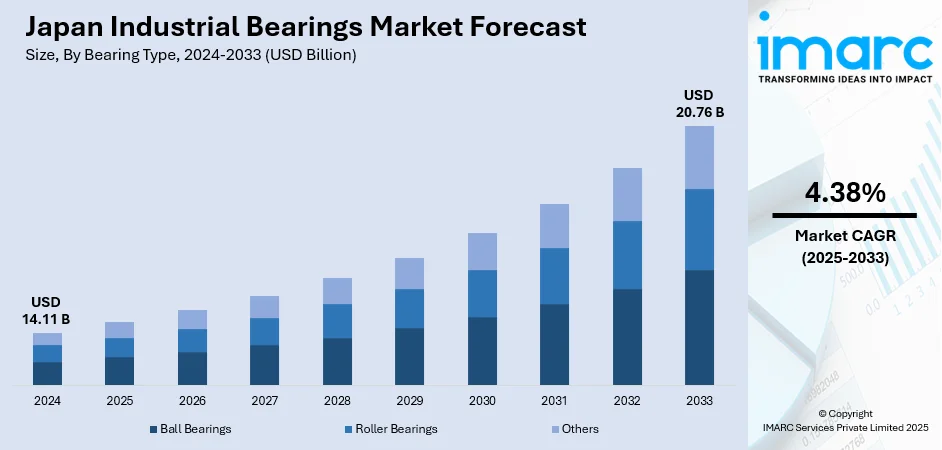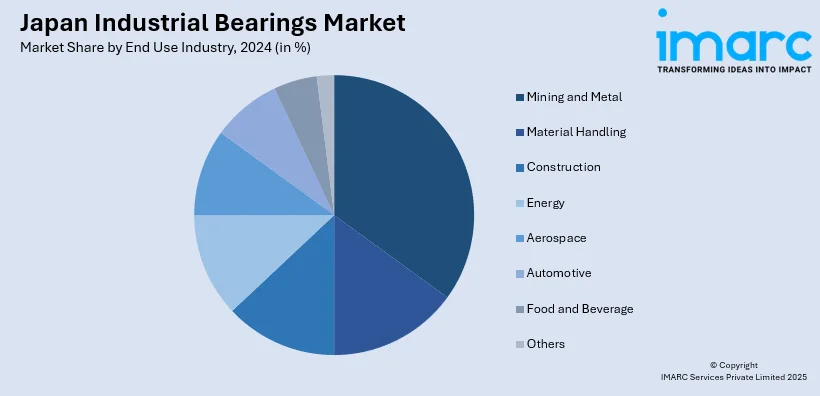
Japan Industrial Bearings Market Size, Share, Trends and Forecast by Bearing Type, End Use Industry, and Region, 2025-2033
Japan Industrial Bearings Market Overview:
The Japan industrial bearings market size reached USD 14.11 Billion in 2024. Looking forward, IMARC Group expects the market to reach USD 20.76 Billion by 2033, exhibiting a growth rate (CAGR) of 4.38% during 2025-2033. The industrial bearings market is growing because of increasing infrastructure investments and an aging workforce. Rising demand for high-performance bearings in transportation, energy, and renewable sectors, along with the shift towards automation due to labor shortages, are other key factors contributing to the expansion of the Japan industrial bearings market share.
|
Report Attribute
|
Key Statistics
|
|---|---|
|
Base Year
|
2024 |
|
Forecast Years
|
2025-2033
|
|
Historical Years
|
2019-2024
|
| Market Size in 2024 | USD 14.11 Billion |
| Market Forecast in 2033 | USD 20.76 Billion |
| Market Growth Rate 2025-2033 | 4.38% |
Japan Industrial Bearings Market Trends:
Rising Investment in Infrastructure Projects
Increasing investments in the development of infrastructure is a key factor influencing the industrial bearings market. Japan's continual growth in transportation, energy, and urban infrastructure is driving the need for bearings capable of managing heavy loads, severe environmental conditions, and uninterrupted operation. These bearings are crucial for maintaining the effectiveness and dependability of vital infrastructure, such as construction equipment, power generation facilities, and transportation networks. Upgrades to infrastructure and the initiation of new projects, especially in renewable energy and transport centers, are catalyzing the demand for high-performance bearings that facilitate large machinery and equipment. A notable instance of this is the 2025 inauguration of Japan’s largest land-based wind farm in Fukushima’s Abukuma region, producing 147 MW of energy to serve around 120,000 homes. This initiative, centered on renewable energy, is part of a larger endeavor to enhance disaster recovery and encourage sustainable growth through corporate power purchase agreements (PPAs) and the cooperation of nine major firms. The renewable energy project in Fukushima emphasizes the growing need for strong and dependable equipment, including industrial bearings for wind turbines, which underscores the rising demand for long-lasting bearings in energy infrastructure. With Japan's ongoing significant investment in renewable energy initiatives and infrastructure, manufacturers are focusing on creating durable, high-performance bearings that endure the extensive operational lifespans needed for these essential systems, contributing to the Japan industrial bearings market growth.

To get more information on this market, Request Sample
Aging Workforce and Skilled Labor Shortage
With Japan's working-age population steadily decreasing, industries are encountering higher difficulties in sustaining operational efficiency, especially in fields that demand specialized knowledge and technical skills. By 2024, Japan's senior population hit a record 36.25 million, with those aged 65 and older representing almost one-third of the entire population. This change in demographics is resulting in a workforce deficit, driving businesses to invest significantly in automation and robotic technologies to sustain output. As a result, there is an increase in the demand for industrial bearings capable of supporting machinery that functions autonomously or with limited human assistance. These bearings are essential for enabling automated systems to operate smoothly, effectively, and with little requirement for human supervision. Moreover, bearings that demand less regular upkeep and can operate in challenging conditions are becoming vital, as businesses aim to lessen the impact of labor shortages and minimize downtime. The growing dependence on high-performance bearings for automated machinery, robotics, and various advanced technologies stems from an aging workforce, driving the market to innovate and deliver solutions that enable industries to maintain efficient operations despite labor limitations.
Japan Industrial Bearings Market Segmentation:
IMARC Group provides an analysis of the key trends in each segment of the market, along with forecasts at the country and regional levels for 2025-2033. Our report has categorized the market based on bearing type and end use industry.
Bearing Type Insights:
- Ball Bearings
- Roller Bearings
- Others
The report has provided a detailed breakup and analysis of the market based on the bearing type. This includes ball bearings, roller bearings, and others.
End Use Industry Insights:

- Mining and Metal
- Material Handling
- Construction
- Energy
- Aerospace
- Automotive
- Food and Beverage
- Others
A detailed breakup and analysis of the market based on the end use industry have also been provided in the report. This includes mining and metal, material handling, construction, energy, aerospace, automotive, food and beverage, and others.
Regional Insights:
- Kanto Region
- Kansai/Kinki Region
- Central/ Chubu Region
- Kyushu-Okinawa Region
- Tohoku Region
- Chugoku Region
- Hokkaido Region
- Shikoku Region
The report has also provided a comprehensive analysis of all the major regional markets, which include Kanto Region, Kansai/Kinki Region, Central/ Chubu Region, Kyushu-Okinawa Region, Tohoku Region, Chugoku Region, Hokkaido Region, and Shikoku Region.
Competitive Landscape:
The market research report has also provided a comprehensive analysis of the competitive landscape. Competitive analysis such as market structure, key player positioning, top winning strategies, competitive dashboard, and company evaluation quadrant has been covered in the report. Also, detailed profiles of all major companies have been provided.
Japan Industrial Bearings Market News:
- In October 2024, JTEKT announced the development of the "High Abilly JFAST" bearing for machine tool spindles, enabling high-speed rotation with grease lubrication instead of oil-air. This innovation reduced energy use, CO₂ emissions, and extended grease life by up to 20%. It supported carbon neutrality goals in manufacturing.
Japan Industrial Bearings Market Report Coverage:
| Report Features | Details |
|---|---|
| Base Year of the Analysis | 2024 |
| Historical Period | 2019-2024 |
| Forecast Period | 2025-2033 |
| Units | Billion USD |
| Scope of the Report |
Exploration of Historical Trends and Market Outlook, Industry Catalysts and Challenges, Segment-Wise Historical and Future Market Assessment:
|
| Bearing Type Covered | Ball Bearings, Roller Bearings, Others |
| End Use Industries Covered | Mining and Metal, Material Handling, Construction, Energy, Aerospace, Automotive, Food and Beverage, Others |
| Regions Covered | Kanto Region, Kansai/Kinki Region, Central/ Chubu Region, Kyushu-Okinawa Region, Tohoku Region, Chugoku Region, Hokkaido Region, Shikoku Region |
| Customization Scope | 10% Free Customization |
| Post-Sale Analyst Support | 10-12 Weeks |
| Delivery Format | PDF and Excel through Email (We can also provide the editable version of the report in PPT/Word format on special request) |
Key Questions Answered in This Report:
- How has the Japan industrial bearings market performed so far and how will it perform in the coming years?
- What is the breakup of the Japan industrial bearings market on the basis of bearing type?
- What is the breakup of the Japan industrial bearings market on the basis of end use industry?
- What is the breakup of the Japan industrial bearings market on the basis of region?
- What are the various stages in the value chain of the Japan industrial bearings market?
- What are the key driving factors and challenges in the Japan industrial bearings market?
- What is the structure of the Japan industrial bearings market and who are the key players?
- What is the degree of competition in the Japan industrial bearings market?
Key Benefits for Stakeholders:
- IMARC’s industry report offers a comprehensive quantitative analysis of various market segments, historical and current market trends, market forecasts, and dynamics of the Japan industrial bearings market from 2019-2033.
- The research report provides the latest information on the market drivers, challenges, and opportunities in the Japan industrial bearings market.
- Porter's five forces analysis assist stakeholders in assessing the impact of new entrants, competitive rivalry, supplier power, buyer power, and the threat of substitution. It helps stakeholders to analyze the level of competition within the Japan industrial bearings industry and its attractiveness.
- Competitive landscape allows stakeholders to understand their competitive environment and provides an insight into the current positions of key players in the market.
Need more help?
- Speak to our experienced analysts for insights on the current market scenarios.
- Include additional segments and countries to customize the report as per your requirement.
- Gain an unparalleled competitive advantage in your domain by understanding how to utilize the report and positively impacting your operations and revenue.
- For further assistance, please connect with our analysts.
 Request Customization
Request Customization
 Speak to an Analyst
Speak to an Analyst
 Request Brochure
Request Brochure
 Inquire Before Buying
Inquire Before Buying




.webp)




.webp)












